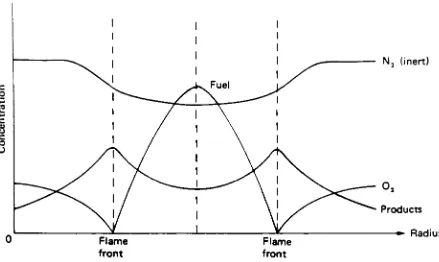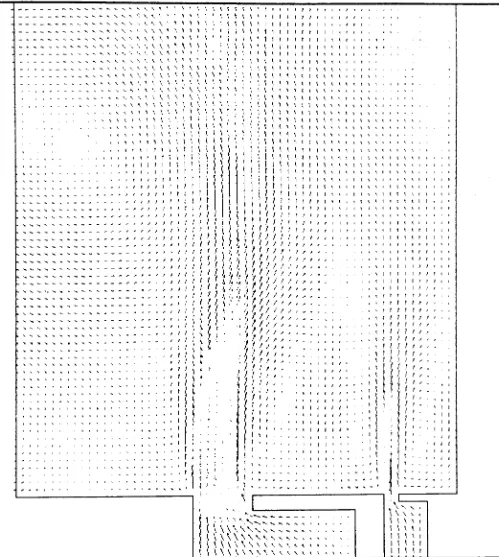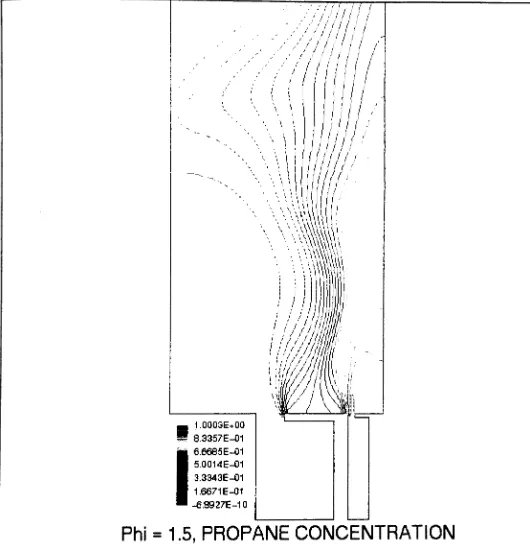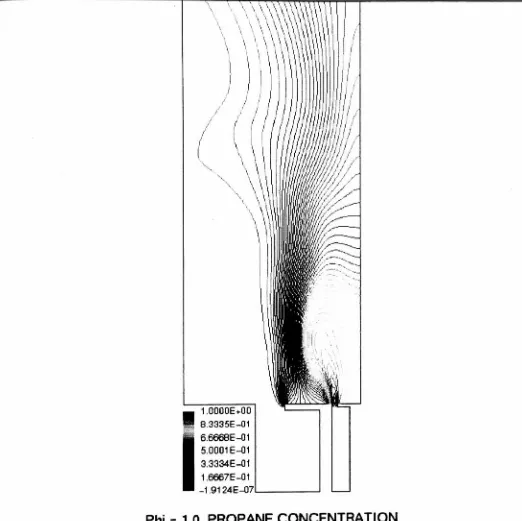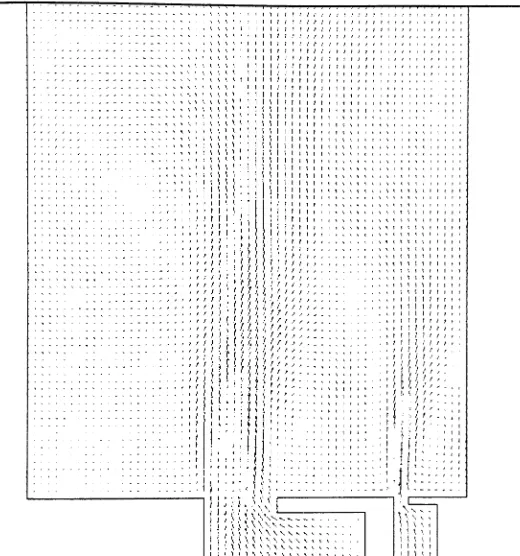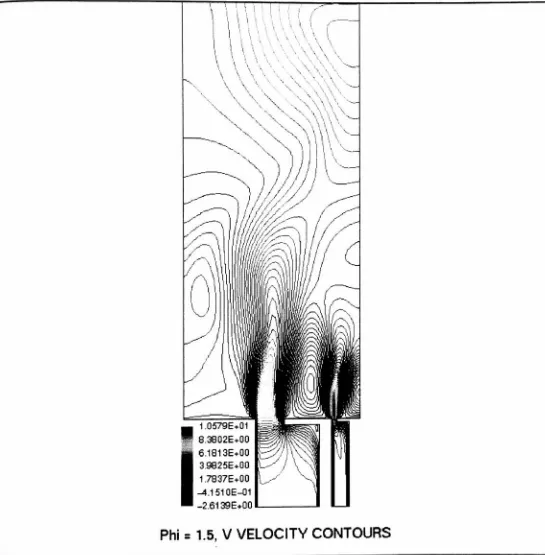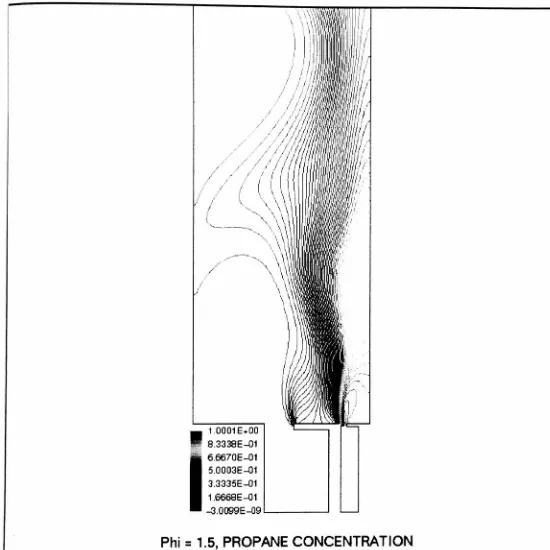Rochester Institute of Technology
RIT Scholar Works
Theses
Thesis/Dissertation Collections
8-1-1995
Experimental and numerical investigation of a
double concentric bluff body flameholder
Peter Eliot Zeender
Follow this and additional works at:
http://scholarworks.rit.edu/theses
This Thesis is brought to you for free and open access by the Thesis/Dissertation Collections at RIT Scholar Works. It has been accepted for inclusion
in Theses by an authorized administrator of RIT Scholar Works. For more information, please contact
ritscholarworks@rit.edu.
Recommended Citation
"Experimental and Numerical Investigation of a Double Concentric
Bluff Body Flameholder"
by
Peter Eliot Zeender
A Thesis Submitted
In
Partial Fulfillment
of the
Requirements for the
MASTER OF SCIENCE
ill
Mechanical Engineering
Approved by:
Professor:
Satish Kanlikar
(Thesis Advisor)
Professor:
_
(Dr.
Alan
Nye)
Professor:
-(Dr.
Ali
Ogut)
Professor:
-(Deptartment Head)
DEPARTMENT OF MECHANICAL ENGINEERING
COLLEGE OF ENGINEERING
AUGUST 1995
PERMISSION GRANTED:
I, Peter Eliot Zeender, do hereby grant permission to the Wallace Memorial Library of the
Rochester Institute of Technology to reproduce this thesis entitled "Experimental and
Numerical Investigation of a Double Concentric Bluff Body Flameholder" in whole or in
part, for educational use only.
December 15th, 1995
Peter Eliot Zeender
FORWARD:
This
work
has been
almost
two
yearsin
the
making,
andit has
provedto
be
the
academic
highpoint
ofmy
engineering
career.The
list
of peopleI
wouldlike
to thank
for
all
their
help,
inspiration,
support
andunderstanding
is
too
enormousto
putto
pen.I
would
like
to
make special note of afew though,
asthis
work wouldbe incomplete
without
their
mention.I
wouldlike
to
thank
Dr.
Kandlikar,
for
putting up
withmefor
solong. He has
been instrumental in maintaining
an academic environmentthat
makeswork such asthis
posssible.
His
endless
support and guidance aregreatly
appreciated.I
wouldlike
to thank
Dr.
Ogut
andDr. Nye
for
aiding
mein putting
this
workinto
its
final
presentableform. I
extend great appreciation
to the
RIT Machine
Shop,
especially Dave
Hathaway,
Jim
Greanier
andTom
Locke for
everything
they
have
done for
me.I
wantto
extend a specialthanks to
Janet
Zandy,
for
directing
my
visionto
the
concerns ofthe
world outsideofengineering,
a giftthat
has helped
to
changemy life.
I
wantto
extendmy
love
andthanks to
all ofmy
family; Mom, Dad, Aaron,
Nathan,
the
fam,
Grandma
andGrandpa
for
giving
methe
supportI
neededto
bring
this
work
to
fruition.
A very
specialthanks to
my
best friend
Tracy
Avgerinos
for
morethan
I
can put
into
words.Thanks
to
allmy
academic peers andfriends,
whohave
played such a vital rolein
my
life
these
pastfive
years.And
lastly,
though
by
no meansthe
least,
my
thanks to
Dr.
Abdel
Hafez,
a mentor without whomthis
work could neverhave
been
concieved.It
washisguidance
andfriendship
that
put me onthe
pathI
amtoday,
I
for
that
I
am grateful.ABSTRACT:
In
the
present
investigation,
the
flow
through
adouble
concentricbluff
body
flameholder is
examined.
The
flameholder
is
studiednumerically,
using commercially
available
computational
dynamics
software
CFDS-Flow3D;
andexperimentally,
using
aburner
test
standconstructed
for
the
study.The
capabilities ofthe
software arefirst
validatedby
anumerical recreation ofexperimental work
done
by Huang
andLin
(1994)
on a singlebluff
body
flameholder. This
work
is
then
extendedby
converting
the
numerical modelsto
include
a propanejet,
serving
as a referencefor
the
double
bluff
body
models.The
flameholder is
numerically
modeled underboth
coldflow
andcombustionconditions
for
a propanediffusion
flame,
for four
separate conditions of operation.An
experimental analysis
is
also conducted withthe test
standto
verify
the
results ofthe
numerical combustionmodel.
The
numericalresultsfor
the
flame
shape and envelopeagreed
closely
withthe
experimentaldata.
VI 1
XI
TABLE OF
CONTENTS:
List
ofFigures
List
ofTables
Nomenclature
1.0
Introduction
1
2.0
Objectives
3
3.0
Literature
Search
4
3
.1
Principles
ofCombustion
4
3.11
Chemistry
ofCombustion
4
3.12
Flames
6
3.13 Flame
Stabilization
8
3
.2 Bluff
Body
Flameholders
1
0
3.3 Review
ofSingle
Bluff
Body
Cold
Flow Analysis
13
4.0
Computational Fluid Dynamics Analysis Overview
1 7
4.
1
Operation
Principles
ofCFD
1 7
4
.2 Numerical Model
for Single
Bluff
Body
21
4.3
Numerical
Model
for Double
Bluff
Body
-Cold
Flow
26
4.4
Numerical
Model
for
Double Bluff
Body
-Combustion
30
4.5
Output
from
the
CFD Code
3 5
5.0
Numerical
Validation Analysis
36
5
.1
Cold
Flow Analysis
ofSingle
Bluff
Body
36
6.0
Double Bluff
Body
Numerical
Analysis
60
6.1
Cold
Flow Analysis
60
6.2
Combustion
Analysis
78
7.0 Experimental
Analysis
96
7. 1
Experimental
Setup
96
7.2
Experimental
Procedure
100
7.3
Experimental Results
102
8.0
Conclusions
114
References
116
Appendices
A.
Sample CFD Command
Files
A-l.
Single
Bluff
Body
withPropane
(Case
II
A)
A-2.
Double Bluff
Body
-Cold
Flow (Case
Alpha)
A-3. Double Bluff
Body
-Combustion
(Case
Alpha)
B.
Sample CFD Output File
LIST OF
FIGURES:
3.1
Standard
Diffusion Flame
Concentration
Profiles
7
3.2 Flow
Pattern
around variousBluff
Bodies
1
1
3.3
Characteristic
Regions
ofFlow,
Huang
andLin
16
4. 1
Model
Outline
for Single
Bluff
Body
23
4.2
Boundary
Conditions
for Single
Bluff
Body
24
4.3
Grid Structure for
Single Bluff
Body
25
4.4 Model Outline
for
Double Bluff
Body
-Cold Flow
27
4.5
Boundary
Conditions for Double
Bluff
Body
-Cold
Flow
28
4.6
Grid Structure for Double
Bluff
Body
-Cold
Flow
29
4.7
Model
Outline
for Double
Bluff
Body
-Combustion
3 1
4.8
Boundary
Conditions for
Double Bluff
Body
-Combustion
32
4.9
Grid Structure for
Double Bluff
Body
-Combustion
33
4. 10
Grid Structure for Double
Bluff
Body
-Combustion,
Enhanced View
34
5. 1
Single
Bluff
Body,
Case
II
(A):
Velocity
Vectors
37
5.2
Single
BluffBody,
Case
H
(A):
Axial
(V) Velocity
Contours
38
5.3
Single
BluffBody,
Case
II
(B):
Velocity
Vectors
39
5.4
Single
BluffBody,
Case
II (B): Axial
(V) Velocity
Contours
40
5.4
Single
BluffBody,
Case
U
(C):
Velocity
Vectors
41
5.6
Single
BluffBody,
Case
II (C): Axial
(V) Velocity
Contours
42
5.7
Single
BluffBody,
Case
HI:
Velocity
Vectors
43
5.8 Single
BluffBody,
Case
IH: Axial
(V) Velocity
Contours
44
5.9
Single
BluffBody,
Case
IV
(B):
Velocity
Vectors
45
5.10
Single
BluffBody,
Case
IV (B): Axial
(V)
Velocity
Contours
46
5.11
Single
BluffBody,
Case
II (A):
Propane
Concentration
52
5.12
Single
BluffBody,
Case
II (B):
Propane
Concentration
53
5.13
Single
BluffBody,
Case
II (C):
Propane
Concentration
54
5.14
Single
BluffBody,
Case
III:
Propane Concentration
55
5.15
Single
BluffBody,
Case
IV
(B): Propane
Concentration
56
6. 1 Double
BluffBody
-Cold
Flow,
Case
Alpha:
Velocity
Vectors
62
6.2
Double
BluffBody
-Cold
Flow,
Case
Alpha: Axial
(V) Velocity
Contours
63
6.3
Double
BluffBody
-Cold
Flow,
Case
Alpha: Propane Concentration
64
6.4
Double
BluffBody
-Cold
Flow,
Case
Beta:
Velocity
Vectors
65
6.5
Double
BluffBody
-Cold
Flow,
Case
Beta: Axial
(V) Velocity
Contours
66
6.6 Double
BluffBody
-Cold
Flow,
Case
Beta: Propane Concentration
67
6.7
Double
BluffBody
-Cold
Flow,
Case
Chi:
Velocity
Vectors
68
6.8
Double
BluffBody
-Cold
Flow,
Case Chi:
Axial
(V) Velocity
Contours
69
6.9
Double
BluffBody
-Cold
Flow,
Case
Chi: Propane Concentration
70
6. 1 0 Double
BluffBody
-Cold
Flow,
Case
Delta:
Velocity
Vectors
7 1
6. 1 1
Double
BluffBody
-Cold
Flow,
Case
Delta: Axial
(V) Velocity
Contours
72
6.
12
Double
BluffBody
-Cold
Flow,
Case
Delta:
Propane Concentration
73
6. 1 3 Double
BluffBody
-Combustion,
Case
Alpha,
Temperature
Contours
8 1
6. 14 Double
BluffBody
-Combustion,
Case
Alpha,
Products Concentration
82
6. 15
Double
BluffBody
-Combustion,
Case
Alpha,
Propane
Concentration
83
6. 16
Double
BluffBody
-Combustion,
Case
Beta,
Temperature Contours
84
6. 17
Double
BluffBody
-Combustion,
Case
Beta,
Products
Concentration
85
6. 18
Double
BluffBody
-Combustion,
Case
Beta,
Propane Concentration
86
6.19
Double
BluffBody
-Combustion,
Case
Chi,
Temperature Contours
87
6.20
Double
BluffBody
-Combustion,
Case
Chi,
Products Concentration
88
6.21
Double
BluffBody
-Combustion,
Case
Chi,
Propane Concentration
89
6.22
Double
BluffBody
-Combustion,
Case
Delta,
Temperature
Contours
90
6.23
Double
BluffBody
-Combustion,
Case
Delta,
Products Concentration
91
6.24
Double
BluffBody
-Combustion,
Case
Delta,
Propane Concentration
92
7. 1
Double Concentric
BluffBody
Burner Test
Stand
98
7.2
Experimental
Setup
Nozzle
Configuration
99
7.3 Experimental
Results,
Cases Alpha
andBeta: Temperature
Contours
108
7.4 Experimental
Results,
Case
Chi
andDelta: Temperature
Contours
109
LIST
OF TABLES:
3.1 Sample
Results
ofHuang
andLin,
Visualization
Study
15
4. 1
Operating
Conditions
for Single
BluffBody
Analysis
22
4.2
Operating
Conditions for
Double
BluffBody
Analysis
22
5. 1 Table
ofResults for Single
BluffBody
Analysis
50
6. 1 Table
ofResults
for
Double
BluffBody
Analysis
-Cold
Flow
77
7.1
Sample
Experimental
Data Sheet
7.2 Experimental
Data,
Case Alpha
109
110
7.3 Experimental
Data,
Case Beta
1 1 1
7.4
Experimental
Data,
Case Chi
1
12
7
.5 Experimental
Data,
Case
Delta
NOMENCLATURE:
B
=body
force (for
turbulence
model)
BA
=aerodynamic
blockage
ratioBR
=geometricblockage
ratioCi,
C2,
C3,
Cn
=coefficients
for
turbulence
modelDA= outer
diameter
of airflow obstruction(disc)
for
singlebluff
body
modelsD0
=outer
diameter
of airflow obstruction(disc)
for
double bluff
body
modelsE
=flameholder blockage
ratio conversion coefficient
f
=mixture
fraction
Fst
=stoichiometric mixture
fraction
F/A
=fuel
air ratio
F/Astoic
=stoichiometric
fuel
air ratioG
=energy
productiondue
to
body
force
(for
turbulence
model)
H
=total
enthalpy
k
=turbulent
kinetic
energy
nif
=mass
fraction
offuel
m,,
=mass
fraction
of oxidantnip
=massfraction
of productP
= shearproduction(for
turbulence
model)
S
=flame
speedt
=time
T
=temperature
u.
=axialvelocity
of annularjet,
from
Huang
andLin
(1994)
Uc
= axialvelocity
ofcentraljet,
from
Huang
andLin
(1994)
U
=gas streamvelocity
UA
=axial
velocity
ofannularjet
Uc
=axialvelocity
ofcentraljet
Umc
=axialvelocity
ofcentraljet,
modifiedfor
CFD geometry
Greek
Symbols:
e =
turbulent
energy dissipation
ratep
=density
U
=viscosity
Uff
=effective
viscosity
Ut
-turbulent
viscosity
X
=thermal
conductivity
O
=equivalence ratio
Subscripts:
a=
annular
jet
(Huang
andLin)
A
=annular
jet (for
velocity)
A
=airflowobstruction,
singlebluff
body
(for
diameter)
c=
central
(Huang
andLin)
C
=central
jet
eff=
effective
MC
=central
jet,
modifiedfor CFD
O
=airflow
obstruction,
double
bluff
body
ST
=stoichiometricStoic
=stoichiometricT
=turbulent
1.0
INTRODUCTION:
The
use of abluff
body
obstruction
for
non-premixeddiffusion
flames is
a commonmethod
for
increasing
flame
stability
in
gasturbine
combustionchambers,
aircraftengines,
furnaces
andmany
otherindustrial
applications.In
orderto
maintain efficient and stablecombustion over a wide range of
operating
conditions,
mostcombustionchambers require aflame
stabilizer ofsome
sort.Generally,
these
stabilizers serveto
broaden
the
range ofcombustion conditions while
maintaining
acceptablelevels
ofefficiency
andstability,
by
decreasing
the
direct
effect ofthe
air stream onthe
flame. This
is
mostcommonly
accomplished
by
the
use of either anairswirler,
or abluff
body
obstructionin
the
airstream.This
workis
an examinationinto
a uniqueconfigurationofbluff
body
stabilizer,
withbluff
bodies
appliedto
both
air andfuel
streams, the
Double Concentric
BluffBody
Flameholder.
The
standardconfigurationfor
abluff
body
flameholder
is
to
place anobstruction(a
disc,
v-gutter,
cone,
or other similarobstruction)
directly
in
the
airflow
ofthe
combustionchamber.
This
servesto
create a recirculation zonedirectly
behind
the obstruction,
in
the
wakeregion.
At
this point,
fuel
is
injected into
the
recirculation zoneto
createthe
flame. The benefit
of
the
bluff
body
obstructioncomesdirectly
from
the
recirculationzone,
andis
twofold.
First,
the
recirculationzoneis
anarea ofdecreased
axialvelocity,
whichgreatly
increases flame
stability
andhinders flame
blowoff,
this
is
the
mostdirect benefit
to
flame
stability.Second,
the
recirculationzone
is
a region ofintense
mixing,
asfresh
airis
both
pulledback
into
the
zonefrom
downstream
to
mixwiththe
fuel.
An
addedbenefit
ofthis
design is
that
during
serving
both
to
preheat
andignite
the
fuel.
All
ofthese
factors
tend to
increase
combustionefficiency
andstability,
as well asincrease
the
operationrange.Bluff
body
stabilization canbe
usedfor both
liquid
andgaseousfuels. For
gaseousfuels,
the
fuel is
injected
directly
into
the
recirculationzonethrough the
injection
nozzle,
whilefor liquid
fuels
an air atomizeris
commonly
usedto
disperse
the
fuel
into
afine
mistfor
efficient
combustion.
The
Double Concentric
BluffBody
Flameholder
incorporates
the
bluff
body
methodofstabilization
into both
the
airstream andthe
gaseousfuel
stream.The
expectedresult ofthis
configuration
is
the
formation
of an additionalrecirculationzoneabovethe
fuel
inlet,
whichshould cause an
increase
in fuel-oxidant
mixing
overthe
singlebluff
body
configuration,
aswellas enhanced
flame
stabilization characteristics.This
being
the case,
this
configuration warrantsfurther investigation in
orderto
better
understandits
performance.As
the
structureofthe
recirculation zone
is
of criticalimportance
to
the
stability
ofthe
flame,
the
presentinvestigation
2.0
OBJECTIVES:
The
mainobjectives
ofthe
present work are:1.
To
modelthe
singlebluff
body
visualizationstudy
ofHuang
andLin
(1994)
using
commercially
available
computationalfluid dynamics
code,
asverification ofthe
capabilities
ofCFDS-Flow3D,
as well asto
serve as a comparisonfor
the
double
bluff
body
analysis.2. To
modelthe
flow
characteristics of aDouble
Concentric
BluffBody
Flameholder
using
CFDS-Flow3D,
underboth
coldflow
and combustion conditions.3.
Construct
adouble
concentricbluff
body
burner
test
stand,
to
be
usedfor
the
experimental section of
the
study.4.
Conduct
anexperimentalstudy
ofthe
flame
to
obtaintemperature
profiles,
and comparethese
withthe
computational work.5. Determine
possiblebenefits
to
fuel-oxidant
mixing
and recirculationofthe
Double
3.0
LITERATURE SEARCH:
3.1
Principles
ofCombustion:
Combustion is
a reaction processthat
is
governedby
both
physical and chemicalconditions.
It
is
the
processwhereby
afuel
reactswithanoxidantin
orderto
releaseits
latent energy
through
an exothermic reaction.The
fuel
andthe
oxidant arethe
reactants ofthe process,
andthe
products ofthe
reactiongenerally
include
carbonbyproducts (carbon
monoxide and
dioxide),
water,
light,
and significant amounts ofheat. There
aremany
conditions
that
affectthe
combustionprocess,
asarethere
oftenmany
effects ofthe
process
(most
generally
someform
offlame
or explosion).The
amountoffuel
and airpresent
is
adefining
factor
ofcombustion,
as arethe
burning
rate ofthe
mixture,
the
flame
speed,
andthe
velocity
ofthe
surrounding
gases.The
mostcommoneffect ofthe
process
is
aflame,
the
visible embodiment ofthe
reaction andthe
release oflight
andheat
The
flame
itself
has
many important
characteristics,
mostnotably
its
combustionefficiency,
adiabatic andmaximumtemperatures,
andlevels
ofstability
andturbulence.
3.11
Chemistry
ofCombustion.
As
statedpreviously,
combustionis
anexothermic chemical reaction.Methane,
for
example,
reactswithoxygenasfollows:
CH4+1.502
CO
+2H20
(3.1)
to
form
carbonmonoxide, water,
heat
andlight.
Or
asfollows:
to
form
carbondioxide,
water,
heat
andlight.
Notice in
both
casesthat
heat
is
releasedand
there
is
nounreacted
fuel
or oxygen.While
oxygenmay
seemthe
ideal
oxidant,
atleast
chemically,
it is
generally
easier,
safer,
and much moreeconomical
to
use airinstead.
Air
reactswithpropane,
for
example,
as
follows:
C3H8
+7(02
+3.76N2)
3C02
+8H20
+26.32N2
(3.3)
to
form
carbondioxide,
water,
heat, light,
withleftover
nitrogen(for
this
example,
airis
assumed
to
contain79% Nitrogen
and21%
oxygen).This
case,
wherethere
is exactly
enough air
to
reactin
combustion with allthe
fuel
to
produce completecombustion,
is
called
the
stoichiometric ratio of air andfuel.
There
arethree
possible mixture ratios of oxidant andfuel
that
canbe
employedto
ensurethe
desired
reaction: stoichiometric(as
seenabove),
excessair,
orinsufficient
air.
The
stoichiometric conditionis
whenthere
is
precisely
the
required amount of airto
completely
combustthe
fuel.
The
excess air conditionis
whenthere
is
more airthan
stoichiometrically
necessary
to
combustthe
fuel
(often many
times the
required amount).This
resultsin
complete combustion ofthe
fuel,
as well as alarge
amount of airremaining
after
the
reaction.The
insufficient
air conditionis
whenthe
amount of airinvolved in
the
reaction
is
less
than the
amountnecessary
to
completely
combustthe
fuel,
oftenleaving
significant portions of
the
fuel
uncombusted,
withlittle
or noleftover
air(only
heated
product gases).
At
this
pointit is
helpful
to
define
the
fuel-air
ratio(F/A),
whichis
the
ratio offuel
as either
the stoichiometric
F/A
orthe
actualF/A. The
stoichiometricFAR
being
that
under
stoichiometric
conditions,
andthe
actualfuel-air
ratiobeing
simply
that
actually
used
in
a given reaction(excess
orinsufficient
air).The
equivalence
ratio(<f>)
is
anotherimportant
property
of a combustiblemixture,
and
is
defined
asfollows:
^
(F/A)actual
<=y
(3.4)
(F /
A)sTOICHIOMETIUC
The
equivalence
ratiois
usedprimarily
to
place a mixtureinto
one ofthe three
categoriesdescribed
above.An
equivalence
ratio of onedenotes
a stoichiometricmixture,
that
greater
than
onedenotes
arich
(insufficient
air) mixture,
andthat
less
than
onedenotes
alean (excess
air)
mixture.3.12
Flames:
A
flame is
loosely
defined
as a combustion processthat
gives offboth
light
andheat. It is
the
most common embodiment ofa combustion reaction.The
most visibleportion ofthe
flame
is
atthe
edge oftheluminous
zone,
andis
calledthe
flame front
orflame
envelope.This
is
the
very
outer shell ofthe
flame,
andis
the
area wherethe
surrounding
air meetsthe
fuel
and combustionbegins
to take
place.The
bulk
ofthe
reaction
between
the
air andthe
fuel
takes
placehere,
andconsequently
this
is
generally
the
region ofhighest
temperature
and product concentration.The
concentration profilesfor
the oxidant,
fuel
and products across adiffusion
flame
front
andinside
the
flame
at aconstant
height
aboveinjection
ports(above
any
recirculationzone)
are shownin Figure
N,
(inert)
[image:20.562.64.503.89.351.2]The
flame
is
initially
characterized
by
how
the
fuel
and air arephysically
brought
together,
as either apremixed
flame
or adiffusion
flame. For
a premixedflame,
the
airandthe
fuel
areintimately
mixedin
non-combustion
conditions,
then
ignited
and supplied withadditional air
to
insure
complete combustion.For
adiffusion
flame,
the
airandthe
fuel
are unmixed prior
to
ignition,
and mixdirectly
atthe
flame front
itself (or
in
the
recirculation region aswill
be
seenlater in
the
Sections
5,
6
and7).
The flame is further
characterizedby
the
flow
characteristics ofthe
injected
fuel
mixture
(for premixed)
and/orthe
characteristics ofthe
gas streamin
whichthe
fuel is
injected
(for
diffusion).
Flames
are also classified aslaminar
orturbulent.
Laminar
flames
tend to
be
much steadier andstable,
with awelldefined flame
length
andshape;
whileturbulent
flames
are oftenunsteady
andwrinkled,
withan overalloscillating
flame
length.
Turbulent
flames
do, however,
offer somedistinct
advantages overlaminar
flames. Their
burning
rateis
muchhigher
astheir turbulent
and wrinkled naturegreatly
increases
the
amount of surface area on
the
flame
front,
andthere
is
generally
moreintense fuel
oxidantmixing
causedby
the
turbulent
nature ofthe
flame.
Both
ofthese
characteristicstend
to
increase
flame
efficiency,
but decrease flame
stability.As
this
is
the
case,
in
practicalapplications measures must
be
taken
to
stabilizeturbulent
flames before
these
benefits
canbe
realized.3.13 Flame Stabilization:
The basic
principleinvolved in flame
stabilizationis
quite simple.Every
flame has
aThe flame
speedis
ameasure
ofhow quickly
the
flame
can consumeincoming
fuel
If
combustion
is
initiated
in
aflowing
stream,
andif
the
gasvelocity U
is
higher
than this
flame
speedS,
the
flame
will movedownstream
at a speed ofU
minusS. If
the
burning
velocity
is
higher,
than
the
flame
will move upstream witha speed ofS
minusU.
Only
when
U
equalsS (or if U is less
than
S
andthere
is
anobstructionto
block
the
flame from
traveling
upstream)
willthe
flame
be stationary
and stable.In
orderto
achievethe
requiredstability for
aflame in
conditions adverseto
combustion,
such asin
high velocity
gasstreams and
low
inlet
temperatures
(as in
aircraftengines)
orfor
awiderangeofoperating
conditions
(as
in
gasturbine engines),
one must use someform
offlame
holder.
The
function
of aflame
holder is
to create,
in
ahigh
speed gasstream,
a regionwhose
velocity
is
lower
than
the
burning
velocity
ofthe
mixture(the
recirculationzone).Flame
blowout
occurs whenthe
burning
velocity
ofthe
flame is
below
the
gas speed at allpoints
in
the
flow
field.
Thus
the
primary design
objectivefor
goodstability is
to
maximizethe
ratio ofburning
velocity
to
flow
velocity;
incidentally
this
is
also a major requirementfor high
combustion efficiency.The
most commonform
offlame
stabilizeris
the
bluff
body
flameholder.
Bluff
body
flameholders
operateby
the
insertion
ofa non streamlinedbody
into
the
gasstream;
causing
arecirculationzone ofgreatly decreased
gasvelocity
(TJ) immediately
afterthe
body,
followed
by
aturbulent
wakeregionthat
follows further downstream.
This,
in
effect,
increases flame
stability
by
effectively
lowering
U for
the
area ofthe
gas streamin
which
the
combustion willtake
place.A
shearregionis
createdbetween
this
recirculationit into
the recirculation
zonefor
stable combustion.
Most
ofthe
hot
combustion productsthen travel
downstream
through the wake, though
someare pulledback
into
the
shearregion and are passed
into
the
recirculation
zoneto
heat up
the
reactants.Figure 3.2
givessample visualized
flow
around some standardbluff
bodies,
by
Isaac,
Chidananda
andSridhara(1976).
As
this
form
offlameholder is
usually
located in
aduct,
hence
avery important
characteristic
becomes
its
geometricblockage
ratio(BR)
as:Duct
Free
Flow Area
Blockage
Area
and a relation
for
the
blockage
ratioto the
aerodynamicdrag
is
asfollows:
(1_3A)2-1=
E(BRX1-BR)2
(3.6)
as
BA
is
the
aerodynamicblockage,
andE
is
a constantbased
onthe
flameholder
geometry.
For
concentric obstructedjets:
BR=D^Dt
(37)
3.2
BluffBody
Flameholders:
There
has
been
a significant amount of research reported onbluff
body
stabilizedflames
through
the years,
andLefebvre
(1983)
reportsthat
extensivedata
and empiricalformulations
are availablein
orderto
predictthe
performance of abluff
body
stabilizeddiffusion
flame.
Figure 3.2 Flow Pattern
around
variousBluff Bodies
(a)
30V-gutter,
BR
=0.31
(b)
30Round-nose,
BR
=0.25
The
bluff
body
flameholder
has been
studied
in
both
coldflow
and combustionconditions,
asboth
yieldinsights into its
performance.A
coldflow
analysisofaflameholder is
generally
anexamination
ofthe
recirculation
andmixing
characteristics ofthe
systemundernon-combustion
conditions.A
combustion
analysisis
performedunder combustionconditions,
and
generally
focuses
onflame
shape,
stability
and combustionefficiency.It
is
seenthat the
focus
of most researchin
this
areais
the
structure,
strength and size ofthe
recirculationzone,
and
its
effects onflame
stability
and efficiency.Li
andTankdn
(1987)
provide a goodoverviewof some of
the
researchdone
in both
coldflow
andcombustion,
aswellas providedetails
oftheir
own visual studies.A
significant amount ofresearchhas
been
reportedin
this
area,
andrecent work of
interest
to this
study
is
briefly
discussed below.
Nikjooy,
So
andPeck
(1988)
offerfinite
ratechemistry
models(analytical)
to
predictthe
reaction region of swirl stabilized and singlebluff
body
obstructed non-premixedflames,
aswellas comparisons
to
their
experimentaldata.
They
found
notonly
that their
finite
ratechemistry
model wasadequateto
predictjet
stabilizedflames,
but
alsothat
ak-epsilon
turbulence
model provedto
be
sufficientfor
non-premixedflames
over afair
range ofoperatioa
Pan,
Schmoll
andBallal
(1992),
conductedadetailed
analysis ofthe turbulence
properties and of
the
recirculation zonestructure ofa conicalbluff
body flameholder,
confinedwithina can-type combustionchamber.
They
presented experimentaldata encompassing
the
differences in
the
recirculationzonebetween
openair and confinedflames.
Shefer,
Namazian
andKelly
(1989,
94)
presentsome ofthe
effects ofbluff
body
stabilization
in
severalvisualization studies.They
present results not unlikethose
ofHuang
andLin
(1994)
as willbe
seenin
Section
3.3,
noting
the
significance of momentumdominance
onthe
structure ofthe
recirculation
zone.There
aresignificant amounts
ofongoing
researchin
this
area,
but
most seemsto
be
aimed at
performance
analysis of specific engines and combustionchambers,
ratherthan
fundamental investigations
into
the principles
offlame
stabilization.3.3 Review
ofSingle
BluffBody
Cold
Flow
Analysis
The
visualstudy
ofHuang
andLin
(1994),
onthe
recirculation zoneof singlebluff
body
flameholder is
of particularinterest
to this
investigation,
andis
usednotonly
to
validate
the
CFD
software,
but
also as a comparisonfor
performance ofthe
flameholder
Their
experimentalsetup
consisted of a central airjet
of3.4
mm outerdiameter,
and anannular
jet
of30
mm outerdiameter,
obstructedby
a20
mmdiameter disc
of0.44
blockage
ratio.Using
a smoke wiretechnique,
Huang
andLin
wereableto
determine
the
shape and size of
the
recirculationzonecreatedby
two
concentricjets
undervariousinlet
conditions
(for
both
the
central andthe
annularjet).
Four
typical
characteristic regionswere
identified
-that
ofweakflow,
prepenetration,
transition,
and penetration.Figure
3.3
illustrates
these
characteristic regions.The
mostinfluential
factor
ofthese
regionsis
the
dominance
in
axial momentum of onejet
overthe
other, this
being
the
majorinfluence
onstability.
The
weakflow
region(Region
I)
is
characterizedby
avery
weakrecirculationzone,
asthe
velocitiesofthe two
jets
aretoo
low
to
createsignificant recirculation.The
prepenetration region
(Region
II),
is
characterizedby
astrong
recirculationzone,
whichis
formed
asthe
momentum ofthe
reverse axialflow
from
the
annularjet
overcomesthat
ofthe
centraljet. This
regionis
further
categorized
into
three
sub-regions(A),
(B)
and(C),
with
the progression
leading
towards
aless dominant
annularjet,
and a recirculation zonesmaller
in
structure.The
transition
region(Region
III)
is
that
in
whichthe
momentum ofthe
centraljet begins
to
overpowerthe
momentum ofthe
annularjet,
andit
begins
to
pierce
through
andbreak
up
the
recirculationzone.It has
alsobeen
observedthat this
region
is generally
very
chaotic andunstable,
often accompaniedby
violent and randomdistortions in
the
shape ofthe
recirculation zone.The
penetration region(Region
IV)
is
characterized
by
a split recirculationzone,
wherethe
momentum ofthe
centraljet
overpowers
that
ofthe
annular reverse axialflow,
andthe
centraljet
column piercescompletely
through the
recirculation area.This
causes adivision in
the
recirculationzone,
resulting
in
aring
shapedzone,
appearing
astwo
smaller sub zonesbetween
the
centraland annular
jets
when viewedacrossthe
cross section.Table
3.1
showsthe
results ofthe
visualizationstudy,
mostnotably
that the
height
of
the
recirculationzonesteadily
decreases
asthe
operating
conditions ofthe
flameholder
move
towards the
penetrationregion,
from
1.10
and1
.20DA
for
casesn
(B)
andII
(C)
down
to
0.70
for
caseIV
(B).
Table
3.1)
Sample Results
ofHuang
andLin,
Visualization
Study
uA
(m/s)
Uc
(m/s)
BR
(-)
Approx. Height
of
Rec. Zone
(DA)
Case
11(B)
0.75
1.79
0.44
1.10
H(C)
0.56
2.03
0.44
1.20
III
0.32
1.52
0.44
1.00
1.00
(m/s)
0.00
0
.52.0
2.5
3.0
3.5
Uc
(m/s)
4.0
COMPUTATIONAL FLUID
DYNAMICS
OVERVIEW:
4.1
Operation Principles
ofCFD:
A
commercialCFD
code,
CFDS-Flow3D,
was usedto
performthe
numerical analysesin
the
presentinvestigation. CFDS-Flow3D is
afinite
volumeCFD
code,
withthe
capabilitiesof
solving
three-dimensional,
compressible andturbulent
flows
of multiplegasand/orliquid
constituents.
The
code solvesthe
conservation equations ofmass,
momentumandenergy
(Navier Stokes
equations) in
discrete
cells,
based
upon userdefined
boundary
conditions,
to
obtain
the
steady
state solutionfor
the
flowfield.
Specifically,
these
equationsarethe
continuity
equation
^
+V(pU)
=0,
(4.1)
dt
the
momentum equation^+V(pUU)
=B
+V-a,
(4.2)
dt
sigma
being
the
stresstensor
o=-p6+n(VU +
(VU)T),
(43)
and
the
energy
equation^
+V-(pUH)-V.(WT)
=^,
(4.4)
dt
oiThe
code employs either ak-epsilon
model or one of several variations of aReynolds
stress model
for
turbulence,
andthe
k-epsilon
modelis
usedexclusively
for
this
investigation.
The k-epsilon
model uses aneddy viscosity hypothesis
for
the turbulence
ofthefluid flow.
This
model alters
the solution
ofthe
Navier
Stokes
equations
by
replacing
the
fluid
viscosity
with aneffective
viscosity,
that
accounts
for
the turbulence
of
the
fluid
flow,
asM-cfr
= u + pT.(4.5)
For
this
modelit is
assumed
that
HT=C,p-(4.6)
The
transport
equationsfor
the
turbulence
kinetic
energy
(k)
andthe
energy dissipation
rate(e)
are:
^pk
_,uT
-r-+
V-(pUk)-V-((u
+-^L)Vk)
=P
+G-pe
(4.7)
and
^
+V-(pUe)-V-((u
+-^)Ve)
=dt
oe
e
e2
C,
-(P
+C2
rnax(G,0))
-C3p--(4.8)
A
mixed-is-bumt modelis
employedfor
gaseous combustion.This
solution methodis
designed
for modeling diffusion
flames,
and approachesthe
solutionfrom
the
contextthat
oxidant and
fuel
cannotoccupy
the
same space without reacting.This
model solvesfor
the
instantaneous
mixture content of each cellin
terms
ofthe
fuel,
oxidant andproduct,
aswellasthe
variancein
these
valuesbetween iterations.
Each
cellmay
only
contain eitherfuel
andproducts or oxidant and products
(either
a rich or alean
mixture),
as all reactantsinstantaneously
create products and releasethe
heat
of combustion ofthefuel.
For
fast
ratechemical
reactions,
the
mixturefraction
(f)
canbe defined
as:f
=^lL_
(4 9)
l-(F/ASt01c)-'
(49)
where
m0
*=m{~T7AT~(410)
and
the
stoichiometric
mixturefraction
(Fyr)
is defined
asF"
=l
i+-i-F/A
(4H)
r /a.Stoic
The
mixturefraction is further
relatedto
the
massfractions
offuel
(mf),
oxidant(m,,)
andproducts
(rrip) by
the
following
f-F
mf
=i_
'
m
='
andmp
=l
~mf
(4-12)
for fuel rich
cells,
andf
mf =0,mo
=l--,andmp
=l-m0
(4
13)
*Vr
The
mixturefractions
andtheir
variances(which
are calculatedwithan extensiveprobability
function)
are calculatedalong
withthe
conservationlaws
until convergence criteria(the
minimization of residuals
for
allvariables)
are obtainedfor
the
steady
state solution.A
separate computational modelis
usedfor
each ofthe
numerical analysespresented,
one
for
the
singlebluff
body
analysis(for
both
the
validationandthe
propaneanalyses),
onefor
the
double
bluff
body
coldflow
analysis,
and onefor
the
double bluff
body
combustionanalysis.
The
singlebluff
body
modelis based
onthe
geometry
ofthe
experimentalsetup
ofHuang
andLin,
andthe
double bluff
body
modelis based
onthe
geometry
ofthe
experimentalsetup
as presentedin Section
7.0. Each
modelconsists of athree-dimensional
solutionfield
that
encompasses
the
desired
region ofthe
flow
field,
internal
solidcellsto
modelthe
nozzlegeometry,
andboundary
conditions
to
modelthe
flow
conditions.The
solutionfield is
divided
into discrete
cells(control
volumes) for
computationalsolution.As only
atwo-dimensional
axisymmetric
modelin
the
axial and radialdirections is
neededfor
eachanalysis,
the
solutionfield is
a single cellin height
and atwo-dimensional
solutionmethodis
employedby
the
solverThe
boundary
conditions employedfor
the
air andfuel inlets
ofthe
nozzlewereturbulent
uniformvelocity
boundaries,
placed atthe
base
ofthe
nozzle.Ambient
pressureboundaries
wereemployedalong
the
sidesofthe
modelto
simulate anopenairdiffusion
flame
A
massflow
outlet atthe
top
ofthe
model allows all massentering
the
system(solution
field)
to
leave,
in
accordancewiththe
law
of conservationof mass.4.2
Numerical Model
for Single
BluffBody:
The
computational
modelfor
the
single
bluff
body
validationanalysis(Section
5.0),
consists
of asolution
field
of6
cmby
10
cm,
divided into
6000
cells,
60
cellsequally
spacedhorizontally
in
100
vertical rows.The
modelencompasses
afull
cross-section ofthe
flameholder,
andthe
solution methodrecognizes
the
model as an axisymmetricsection.Figure
4.
1
showsthe
outline ofthe
modelgeometry,
figure
4.2
showsthe
placement ofthe
boundary
conditions,
andfigure
4.3
showsthe
structure ofthe
grid(cells). The
nozzlegeometry
wasmodeled as solid
cells,
withnoslip
boundary
walls,
andhas
a30
mm exitdiameter for
the
annular
jet,
obstructedby
20
mmdisc
(DA)
asin
the
experimentalsetup
ofHuang
andLin.
The
exitdiameter
ofthe
centraljet
wasincreased
to
4
mm(from 3.4
mm)
in
orderto
serveas a
better
comparisonfor later
sections,
asit
allowedfor
a grid structure more similarto
later
models.The
magnitude ofthe
centraljet
velocity
(Uc)
has
been
modifiedfor
allcases(and
retermedthe
modified centraljet
velocity
(Umc)),
to
maintainthe
samevolumeflowrate
asthose
studiedexperimentally
by decreasing
the
axialvelocity in
accordancewith
the
increase
in
area.The
nozzle section accountsfor
the
lower 3
cm ofthe model,
leaving
7
cm of solutionfield
in
the
wake region.The
velocities ofthe
central(Umc)
andannular
jets
(Ua)
are
givenin Table
4.1.
The only
appreciabledifference between
the
coldflow
validation modeland
the
coldflow
model withpropaneis
that
a secondfluid is
present,
sothe
solution method must account
for fluid
mixing.Table
4.1)
Single
BluffBody
Analysis
Case
uA
Uc
uMC
BR
k
611(A)
0.75
1.4
1.0
0.44
0.00196
0.10026
n<B)
0.75
1.79
1.28
0.44
0.00329
0.18499
H(C)
0.56
2.03
1.45
0.44
0.00423
0.26983
ni
0.32
1.52
1.09
0.44
0.00237
0.11327
IV
(B)
0.47
2.96
2.12
0.44
0.00899
0.83651
Table
4.2)
Double
BluffBody
Cold
Flow Analysis
Case
<D
BR
uA
Uc
k
eAlpha
1.0
0.53
2.732
2.282
0.01491
0.21702
Beta
1.5
0.53
2.732
3.423
0.01491
0.21702
Chi
1.0
0.44
2.732
2.282
0.01491
0.21702
Mass Row
Boundary
a c 3
O CO
CO
c u
S
<
Walls
>i. i- i.
A
"O c 3
o CQ
2
3
03
1
c
E
<
A
A
nA
-- aAir
Air
(Fuel)
Air
Velocity
Inlets
'I
a
a aaaaaaaaaaaaa !
iiiitiiiiiitiiiiiiiiiiiiiii
i I
^>
1 1 1 1 1 1 m 1 1
1 t+i
=ffl
iiiini
-;!>
I i
mini mmmmiiiiiiiiii
""!!!!!!!!!!!!!!!!!
;::::::::::>
"""":::"":"!:
a
iaiitsiiaaaaaaaaBiaaaaaaaaiaiaBaaaaaBafaaBiaaaBaaaaaaaa
a*ala>,a*1""""1"
iiaii iiiiiiiiii an ""
i aiiiiii
!!!!"!"!
' Ill
SBaa.BaaaaBiBaBBiBaaaBBaBiaaaBaBjBaaBaaaBjBajBaBBBBaBa
'*l^"*',,'*i"'*""1112IJ
4.3 Numerical
Model
for
Double
BluffBody
-Cold Flow:
The
computational
modelfor
the
coldflow
double bluff
body
analysis(Section
6.1)
is
3
cm wide
by
10
cmtall,
and consists of12000
cells,
60
cellsequally
spacedhorizontally
in 200
vertical rows.
Figure
4.4
showsthe
outline
ofthe
modelgeometry
(note
that
D0
is dependent
on
the
geometricblockage
ratio ofthe
disc,
andis
28.0
mmfor
BR
=0.53
and
is
26.0
mmfor
BR
=0.44),
figure
4.5
showsthe
placement ofthe
boundary
conditions,
andfigure
4
6
showsthe
grid structure.The
blockage
ratiofor
the
centraljet
obstructionis
0.57.
There
aretwo
significant
differences between
this
model andthat
ofthe
singlebluff
body
flameholder.
First,
the
griddensity
wasincreased
to
accountfor
the
finer
geometry
ofthe
centralbluff
body;
andsecond,
the
modelonly
encompasses an axisymmetric sectionfrom
the
centerlineoutward,
essentially
half
the
size ofthe
previous model.A symmetry
planehas
been
added atthe
centerline of
the
flameholder
in
orderto
modelthe
effectsofthe
entire cross-section.The
nozzle
geometry
was modeledin
the
same manner asthe
previous models(as
solidcells),
andagain encompasses
the
lower
3
cm ofthe
model,
leaving
7
cm ofsolutionfield
for
the
wakeregion.
The
central(Uc)
velocity
is for
propane and annular(UA)
velocity
is for
air,
andtwo
separate geometric
blockage
ratios(for
the
airobstruction)
wereexamined,
allare as givenin
Table 4.2.
Otherwise
the
solution methodis
identical
to
that
ofthe
singlebluff
body
propaneextensionmodel.
85.0
mm15.0
mm< >
5.0
mm-
4.0
mm*
18.0
mm30.0
mm2.0
mmMass Flow
Boundary
o
c 3
O
CD
3co
CO
!
C<U
E
<
A
Walls
A
ji i. i.CL
E
E
Air
Fuel
Velocity
Inlets
4.4 Numerical
Model for
Double
BluffBody
-Combustion:
The
computational
modelfor
the
double
bluff
body
combustionanalysis(Section
6.2)
consists of
three
solution
fields
(termed
blocks
in
the
CFDS-Flow3D
commandcode),
joined
together.
The
first
containsthe
internal
solids andflow
passagesfor
the nozzle,
whilethe
othertwo
arefor
the
downstream
region.As
the
first
sectionis
ofsignificantly less
widththan the
third,
the
second sectionis
tapered to
allowfor
smoothtransition
between
them.
The
first
section
is
5
cm wideby
1
.5 cmtall, containing
3000
cells,
100 equally
spacedhorizontally by
30 equally
spacedvertically
(note
that
eachsection/blockcontainsthe
samenumber ofhorizontal
cellsfor
continuity).The
second sectionis
3
cm wide atthe
base,
20
cmwideatthe
top,
13.5
cmtall,
and contains4000
cells.The
third
sectionis
20
cmwideby
25
cmtall
andcontains
4000
cells,
divided into
40
rowsin
averticalgeometrical progression.The
geometricprogression
increases
the
height
of each cellin
accordance withits distance
form
the
base,
sothe
gridis
essentially
finer
atthe
base
ofthe
block,
and courseratthe
top
ofthe
block. Figure
4.7
showsthe
outline ofthe
modelgeometry,
figure
4.8
showsthe
placement ofthe
boundary
conditions,
figure
4.9
showsthe
grid structure ofthe model,
andfigure
4. 10
is
an enhancedviewof
the
grid structurein
the
first
block.. This
modelis
significantly larger
than
each ofthe
previous models
(geometrically
speaking),
and again encompassesthe
axisymmetric sectionfrom
the
centerlineoutward,
withasymmetry
plane atthe
centerline.The
nozzlegeometry
is
defined in
muchthe
same manner asthe
previoussections.Again,
the
centralvelocity
(Uc)
is
propane,
andthe
annularvelocity
(UA)
is
air,
andtwo
geometricblockage
ratios arestudied,
allare as given
in
Table 4.2.
250.0
mmMass
Row
Boundary
a c 3 o
CQ
2
3
c
IS
E
Ambient
Pressure
Boundary
Nozzle
Boundary
Conditions
asin
Figure 4.5
,:.-.v.-\^.^C*.\^vc^^^
aTaW '.--.'
\\\\^XCS>X'X-Y>\<V\VX\\.V\\\V\\\CA\\\\\\\V0AV\V.\\\VHt>UV.HUH11\Hllll ">\ '^\-XV\C.W.".
"
\\\WVVW-NC-V>\\VWWWAV.'.rtl'UhW U\ \\m.U\HU! Ii<1 1
. v.
'a',X\V'.\\v;.'
v.'.\s -v\-'\\\VVC.WV.V.'.VAXV^Mt'M.M'itt.'.U'.tlHir.ll
--\\vkV^-k-WV.Vk'-kVV.'VWWV.r.'-.W V.\ V-.'VA VO0Hv.\-IHHVVUMUUilll
Figure
4.10
Grid Structure for Double
BluffBody
4.5
Output
from
the
CFD Code:
CFDS-Flow3D
offers solution outputin
two
forms,
tabular
data
outputin
the
form
ofa
data file (as
seenin
Appendix
X),
or graphicaloutput,
in
the
form
ofvector andcontour plots of
the
data.
For
the
purposes of comparisonthe
latter
is
mostappropriate,
and
the
majority
ofthe
computational results givenin
this
study
willbe
presented asvectorand contour plots.
These
plots are availablefor
eachvariablethat
is
solvedfor in
the
code.For
the
coldflow
models ofthe
singlebluff
body
andthe
double bluff
body
flameholders,
the
variables solvedfor
included:
uvelocity,
vvelocity, pressure,
density,
viscosity,
k,
e,
enthalpy
and a single massfraction
(percent
offuel in
cellby
mass).For
the
double bluff
body
combustionmodels,
the
variablesincluded
all ofthe
above,
aswell as:temperature,
three
massfractions (one
for
percentoxidant,
onefor
percentfuel,
onefor
percent
products),
andtwo
combustionscalars(mixture fractions).
5.0
NUMERICAL
VALIDATION ANALYSIS:
5. 1
Cold
Flow
Analysis
ofSingle BluffBody:
In
orderto
verify
the
capabilities
ofthe
Computational
Fluid Dynamics Solver
Code,
part ofthe
experimental research ofHuang
andLin
was recreatednumerically
withthe
code.This
was undertakento
verify
the
capability
ofthe
codeto
accurately
modelthe
recirculation
zone,
andlater
to
serve as abasis
of comparisonfor
the
double bluff
body
configuration
The
initial
object ofthis
validation wasto
clearly
reproducethe three
characteristic
flow
regionsfound
by Huang
andLin,
andshowthe
effects ofmomentumdominance
onthe
recirculation zone.Five
individual
cases werestudied,
based
onthose
ofHuang
andLin,
and are asdefined
in Table 4. 1. Of
allthe
output availablefrom
the
code,
the
axial(V)
velocity
contours providethe
clearestdepiction
ofthe
structure ofthe
recirculation
zone,
whilevelocity
vectorplotsofthe
region showthe
effect ofthe
recirculation zone.
Figures 5. 1
through
5.10
depict
the
velocity
vectors andV velocity
contours of
the
five
cases studied.Cases
n
(A),
(B),
and(C)
are representative ofthe three
sub-regions ofthe
prepenetrationregion.
Figures
5.1,
5.3, 5.5,
5.7
and5.9
(the
velocity
vectorplots) clearly
show recirculation
behind
the
bluff
body
obstruction,
but
the
V velocity
contour plotsyield much
better
information
asto the
structure ofthe
recirculation zone.For
Case
II
(A),
Figure 5.2 clearly
showsa stablerecirculationzonedominated
by
the
reverseflow
ofthe
annularjet. This
is
evidentby
the
purpleregions whichdenote
negative axialvelocity
(or
recirculation).The
zonehas
the
expected closedtoroidal
shape similarto that
shown3.-3-&9ftB-!qi
Q.'^&oq^qq;
i
r
i i r i i
r
ii
r
i . .
t 1 i I I i I , i I , i I
?
I I .
I
I
f
i i
r
i i
r
i i i i i i i i i i i i i i 1 i
4
4i
*
r
rf
If
rMM,
i it
1
i 11 j ,
,. i r 1 f < r t I I I I I I
\ \ \ \ i.
r 'i w
\
\ \i i \
,
',
ir i
f i
r . 1 s 1 . . .
r
m
i
r 1 1 i
\
1 1
? 1 i
,
i
i
i r . i 1 i i 1
1
.1
1
1 i iI
M 1
I
I
I I i r i rI
t
rr
i i i r 1 1 i r r
i i r t I I f I I } I
I
f
IMM
r
1
f
t
1
I
.1
.
1
r r 1
r r 1
r r 1
1 1 t . i r i i r . I f
1 i r .
1
r
1 i i i
l
i
1 i i
. 1 i
. 1 i
. i i t
I
i i i1
t ,
1
l
i1
l
i '1
)
\
i
'i
I
i
'i
\
i i'i i
i 'i i
i i i i i i i i i
(,
\
\
\
\
i
<V \ 1 ,
\ \
s \ )\
t \ 1. * 1
t 1
< i i
. i i
i i 1 i i 1
, i i
Ji
\
i '.
\
i'i
',
i
'i
1
ii
., i i
i i i
t . i '.
5
' iri
\
r . i
i
' \ ii *
I i 1 h
*
%
1
^
i
, , k 1
i
1 1 ' i i t 1
'
[
I 1. *.
ii
f s / /
,
/ f
1
1
1 1
I
t
f
I ?
I
I
t
M M
r ) f
) t f
r t t
f
tI , 7
i1
r
